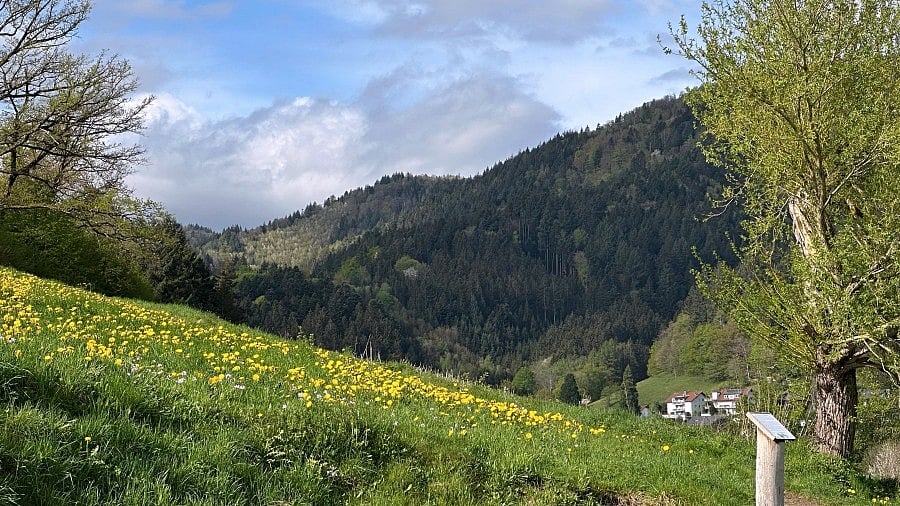
A section of the verdant Black Forest from atop the Kamelberg Hill.
Credit: Photo by author
Mist swirled through the valleys as we drove deeper into Germany’s Black Forest. Towering pines loomed over us, their dark silhouettes stretching endlessly into the hills. The first signs of spring appeared in bursts of wildflowers along the roadside, while clusters of timber-framed houses sat quietly at the edges of villages, their steep roofs weathered by years of snow and rain.
This vast 6,000-square-kilometre forest extends from the Swiss border near Basel to Karlsruhe in the north, bordered by the Rhine Valley to the west and the rolling hills of Baden-Württemberg to the east. To put its size into perspective: it’s larger than Goa, almost twice the size of Delhi, and about ten times bigger than Mumbai, which spans just 603 square kilometres. Beyond its size, the Black Forest is steeped in folklore, inspiring the Brothers Grimm’s Hansel and Gretel and countless tales of enchanted woods and mythical creatures. We arrived in the evening, just as the last light faded beyond the hills.
A faint chill hung in the air, carrying the crisp scent of pine and damp earth. In the meadows, the first spring blossoms had begun to open, dotting the green expanse with soft pastels. The silence was almost complete, broken only by the crunch of gravel beneath our tires as we pulled into our accommodation at the foot of the Schauinsland Mountains.
By morning, the world had transformed. The forest was alive with the sounds of rustling leaves and babbling brooks. Eager to explore, we set off on foot, following Grosstalstrasse, where the Reichenbach stream tumbled over rocks, winding its way through the shaded woodland. The climb up Kamelberg, a 527-metre hill, offered views of farmhouses nestled in the folds of the valley. Wooden sculptures by Thomas Rees stood like forgotten relics of myth.
Further south, the Triberg Waterfalls, some of Germany’s highest, cascade over 163 metres of tiered rock, sending mist into the air and creating narrow trails alongside the falls. For the hardcore hiker, the climb to Feldberg, the highest peak at 1,493 metres, rewards with sweeping views that stretch as far as the Rhine Valley and into Switzerland. Nearby, Belchen Mountain, quieter and less crowded, offers equally breathtaking views, with its rolling summit providing uninterrupted panoramas of the forest below. To truly experience German culture, a sweaty hike should end with a visit to the sauna, where you shed both your inhibitions and your clothes. The showers, changing area, and sauna itself are all communal and unisex, a space where modesty feels more like a foreign concept than a necessity. As first-time sauna-goers, we instinctively clung to our towels, only to realise we were the only ones doing so.
Around us, seasoned visitors lounged freely, using their towels for comfort rather than modesty. We went twice, each time braving the Aufguss ritual, where a hot, wet towel is swung through the air, sending waves of searing, humid heat rolling through the room. The intensity builds with each round, the heat pressing against your skin and forcing deep, cleansing breaths until the final wave has passed. The next day, we left behind the solitude of the Black Forest and headed towards Freiburg. Just two hours from France and ninety minutes from Switzerland, this university town is one of Germany’s warmest and most historic cities. Founded in 1120, Freiburg grew into a prosperous market hub at the crossroads of medieval trade routes, connecting the Mediterranean to the North Sea and the Rhine to the Danube.
Over the centuries, the Austrian Habsburgs, French conquerors, and German rulers have left their mark on the city. The Catholic Church once presided over its wealth, first through the Bishops of Constance and later powerful monasteries, many of which still stand today. Even Freiburg’s iconic cathedral, Freiburg Munster, was once part of Austria — a reminder of the city’s shifting allegiances before it finally became German. Freiburg’s greatest challenge came during the Second World War.
In November 1944, British and American bombers devastated the city, reducing much of the old town to rubble. Unlike some cities that modernised their ruins after the war, Freiburg chose to restore its historic centre to its former glory, carefully rebuilding its medieval streets, timber-framed houses, and towering Munster. Today, the city stands as both a testament to resilience and a living piece of history, blending centuries-old architecture with a vibrant café culture. We joined John, a fast-talking American expat, for a free walking tour that unravelled Freiburg’s past with equal parts history and dry humour. He led us past City Hall, through the medieval Schwabentor, and into the shadow of Freiburg Munster, its 116-metre spire dominating the cobbled streets.
Inside, light filtered through centuries-old stained-glass windows, casting colourful patterns over intricate stone carvings. Beneath our feet, Bachle, the city’s narrow water channels, wound through the streets. Local superstition says that if you step into one, you must marry a Freiburger. At Munsterplatz, the farmers’ market was alive with cheeses, cured meats, and seasonal produce. We wove through stalls selling handcrafted cuckoo clocks, their intricate wooden gears ticking in measured precision. But the indulgence not to be missed is the Black Forest cake, where layers of chocolate sponge, tart cherries, and whipped cream come together in perfect harmony.
On our final morning, we walked through sunlit meadows, past the local village church, and slid down a muddy embankment. The thought of simply lying back in the fields, watching spring unfold and listening to the rustling leaves and distant birdsong, was tempting. Instead, we made our way back, rustled up some anda bhurji, swapping local cherry tomatoes for the usual ones, and indulged in a makeshift bhel puri, savouring one last meal before reality called us back. The dreamy Black Forest faded from view, replaced by the hum of motorways and the inevitable pull of the urban jungle.